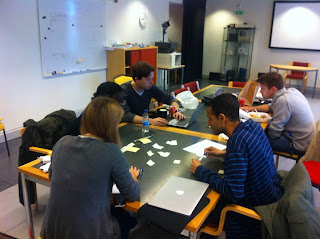Group name
New revenue opportunities for digital magazines.
What we have done
We spent the last weeks mainly with brainstorming and desk research to develop our scenario and the idea that we want to work on. During these extensive brainstorming sessions we identified several domains where we can discover the future revenue sources. The two principal revenue sources for magazines are: consumer revenue and advertising revenue. To be more detailed, we separated different kinds of revenue sources on the consumer side. As a result, principal domains “Advertising”, “Copy sales” and “Subscription sales” have been identified. Because another group is focusing entirely on the future of advertising, we’ve decided to focus more on upping the revenue through paid content. We tried to develop a concept of how the different revenue sources are connected and which forces drive them (see picture below):

One way of upping that revenue is to increase the price of the magazines, another is to increase the amount of customers using the product. To be able to increase the price without harming the relationship with the customers you really need a product the customer is willing to pay extra for. We assume that a more thorough study of ways to increase readership is a better study topic, as it has more space for creativity rather than standard calculations. Independent price changes are not an effective method of regulating the number of readers without strategy changes.
This far we’ve come up with two solutions about how to increase the volume of readers. Cafés, airports and other public “places” often provide magazines and newspapers to customers to make their time more pleasant and attract more people. Our idea is to translate this into digital magazines with a solution around technologies like “near field communication”. The second idea is about social recommendations and discounts. The readers should want to participate in increasing the volume of each issue, because then they will get it cheaper.
What we will do
Next week we are going to interview a Russian-American expert about magazines. He is a member of global WAN-IFRA board and the head of digital media lab at Russia's largest news agency. We will also work on finding a company who changed their strategy in digital content and who actually succeeded. To understand what has been done in the past can help us understand what is going to happen in the future.
We have a lot of work with our solutions but as soon we have our ideas ready we will send out a survey to the magazine users to check what they are thinking of our solutions and what they really want. Our project will probably lead to more than one solution due to the broad subject. Even though we will focus more on the revenue from paid content we cannot ignore the fact that advertising is a big part of today's magazines. Therefore we will also look into this category and ways to raise the revenue through changes there.
Furthermore, we want to look into other ways to boost readers' spending: mainly by offering supplementary digital services, but also through events and merchandise.
Problems encountered
A big issue for us is to not step on other groups toes when coming up with new ideas. We find it really hard to come up with a totally new revenue source and if we use the existing ones our solution would probably be developments in either the product, the distribution or the business model. Changes in these areas could certainly increase the revenue, our problem is that other groups already are looking at the future in these areas.
Another problem is that we find it difficult to come up with “the radical change” in technology or behavior connected to finding new revenue sources. The revenue model for magazines has always been pretty simple and even though there are new sources of revenue like events, the two main sources have been the consumer through sales and advertising for the last decades. We will have to work a bit more on crystallizing the radical change in our scenario.
Changes in the project
There have not been major changes in the project, but more effort has been put into narrowing down the ideas we’ve had so far.















